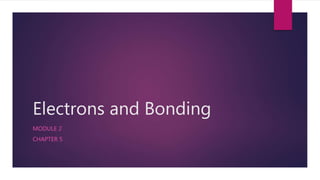
Electrons and bonding
- 1. Electrons and Bonding MODULE 2 CHAPTER 5
- 2. Electronic Structure Shells They are regarded as energy levels Energy increases as shell number increases Shell number is the principal quantum number (n) Electrons in shells Electrons have properties of waves and particles Maximum number of electrons in shell = 2n 2
- 3. Electronic Structure Maximum number of electrons Energy level Number of electrons 1 2 2 8 3 18 4 32
- 4. Electronic Structure Orbitals A region around a nucleus that can hold up to two electrons with opposite spins or a high probability of finding an electron Each orbital (s , p , f , d) is a different shape S orbital Spherical Each shell contains one The greater the shell number (n) the greater its radius
- 5. Electronic Structure P orbital Dumbbell shape Each shel from n=2 contain a three (at right angles from eachother) Greater the shell number (n) the further it is from the nucleus D and F orbitals Double dumbbell shape Each shell from n=3 has five d orbitals Each shell from n=4 has seven f orbitals
- 6. Electronic structure Sub shells Each new shell gains a new type of orbital Number of orbitals increases with each orbital Number of electrons in each sub shell also increases Orbitals fill in order of increasing size Each new type of sub shell has a higher energy However 4S fills before 3D
- 7. Electronic Structure Electrons pair with opposite spins Electrons have a negative charge so repel one another, and hence have a property called spin (shown by either an upwards or downwards arrow) to counteract the repulsion Orbitals with same energy are occupied singularly first One electron occupies each orbital before pairing starts, this prevents repulsion until there is no other choice
- 8. Electronic Structure Eectronic Configuration E.g. Lithium 1S 2 , 2S 1 Can be written in shorthand using the previous noble gas’ chemical symbol and the remaining electron sub shells Ions Positive ions are cations they’re formed when atoms lose electrons Negative ions are anions they’re formed when atoms gain electrons
- 9. Electronic Structure Blocks on the periodic table S block (highest energy electrons in s sub shell) left block of two groups P block (highest energy electrons in p sub shell) right block of six groups D block (highest energy electrons in d sub shell) centre block of ten groups Ions of S and P block elements Highest energy sub shells lose of gain electrons Ions of D block elements 4S sub levels fills and emptied before 3D (as 4S has lower enegy)
- 10. Ionic Bonding and Structure Ionic bonding It is the electrostatic attraction between positively and negatively charged ions. Popular cations: metals and ammonium Popular anions: non-metals and polyatomic ions Ionic compounds Outer shell electrons from a non metal atom are transferred to the outer shell of a non metal atom Cations and anions are formed Ions have same configuration as noble gases (full outer shell)
- 11. Ionic Bonding and Structure Structure of ionic compounds Each ion attracts oppositely charged ions in all directions This results in a giant ionic lattice structure containing lots of ions Properties of ionic compounds Melting and boiling points: Almost all ionic compounds are solid at room temperature. There are very strong electrostatic forces of attraction between ions so bonds need a lot of energy to be overcome (giving the compounds high melting and boiling points). The greater the ionic charge the larger the strength of the bonds and hence higher the melting point
- 12. Ionic Bonding and Structure Solubility: Many ionic compounds dissolve in polar solvents (e.g water) as the positive and negative charges of the molecule attract the ions. The greater the ionic charge thr stronger the bonds between the ions so compounds become less soluble Electrical conductivity: ionic compounds conduct electricity when molten or dissolved as the ionic lattic breaks down allowing ions to be mobile and carry a charge
- 13. Ionic Bonding and Structure Teeth The enamel on your teeth is made of the ionic compound calcium hydroxyapatite which can be removed in acidic conditions (resulting in tooth decay). Saliva helps neutralise the acid but it’s not always enough, so toothpaste contains fluoride in the form of calcium fluoride which replaces lost ions by forming fluoropatite which is stronger and more resistant than hydroxypatite
- 14. Covalent Bonding Covalent compounds and molecules Covalent bonding is the strong electrostatic attraction between a shared pair of electrons and the nuclei of the bonded atoms. It occurs between atoms in: non metals, compounds of nom metals and polyatomic ions The atoms are bonded together into a single unit: a small molecule (H2), a giant covalent structure (SiO2) or a charged polyatomic ion (NH4 +)
- 15. Covalent Bonding Orbital Overlap A covalent bond is the overlap of atomic O rbitals, each containing one electron, to give a shared pair of electrons The shared pair of electrons are attracted to the nuclei of both bonding atoms Bonded atoms often have the same electronic structure as a noble gas (full outer shell)
- 16. Covalent Bonding Localised The attraction is localised (directional) and hence acts solely between the involved atoms. This can result in a small unit (a molecule). A molecule is the smallest part of a covalent compound that can exist whilst retaining the chemical properties of a compound Lone pairs Paired electrons that are not shared
- 17. Covalent Bonding Multiple covalent bonds Two atoms share more than one pair of electrons (e.g double and triple) Examples include carbon dioxide (double bond) and nitrogen (triple bond) Dative covalent bond A active (co-ordinate) bond is one in which the shared pair of electrons come from one atom (originally the lone pair). Usually bonds to a H+ ion Shown in display formula as arrow from the donating atom Average bond enthalpy A measurement of covalent bond strength (larger = stronger )